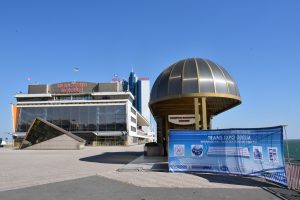In recent years, South Africa has downsized its domestic railway freight network with the closure of many branch lines, and now long line-ups of big trucks carry coal to some of South Africa’s coal-fired power stations. So, like many other African nations, South Africa’s economy depends on truck transportation.
Short-sea shipping and domestic maritime transportation occurs in many countries, mainly involving bulk freight movement. On North America’s Upper Great Lakes, massive ships carry mega-tonnage of bulk cargo at much lower cost per ton than overland transportation, even on distances of under 500 nautical miles. Internationally, Roll-On Roll-Off ferry vessels carry truck trailers on many short sea shipping routes.
Many manufacturing industries function at South Africa’s coastal cities such as Cape Town, Port Elizabeth, Durban and East London. The big inland city of Johannesburg connects to both Port of Durban and Port of Maputo that has capacity for further development.
While the railway connection between Durban and Johannesburg operates near full capacity, there is scope to further develop the railway line between Johannesburg and Port of Maputo at lower cost than between Durban and the Greater Johannesburg area. Future innovation in railway transportation applied to the Maputo – Johannesburg link could increase the number of containers that move along the line and potentially at lower cost than along the Durban – Johannesburg line. Such a possibility increases the future need to expand the container terminal at Port of Maputo.
Changing weather patterns that involve more frequent drought cycles and the limited future supply of potable water could restrict future population growth in the Greater Johannesburg area (population over eight million), with future growth occurring the Greater Cape Town, Greater Durban — Pietermaritzburg and Port Elizabeth – East London regional area. Seawater desalination is possible at these coastal areas. The 25-million combined populations of coastal provinces of Western Cape (6.8 million), Eastern Cape (6.7 million), Kwa-Zulu Natal (12 million) exceeds the 15 million inland population of Johannesburg and Gauteng province with possible future stagnation in population growth.
Future growth of the coastal area population increases likelihood of future economic development of coastal cities along with expansion of manufacturing near maritime ports. While raw materials would move between inland locations and coastal cities, a greater proportion of manufactured goods would move between coastal cities including via coastal maritime transportation. While slower than truck transportation, maritime RO-RO transfer of road trailers would involve transportation lower cost and less risk of theft while in transit than overland transportation. Trucks interlined with RO-RO vessels would undertake shorter haul journeys within expanded metropolitan areas.
Coastal RO-RO vessels carrying road trailers and containers could sail amongst the ports of Cape Town, Port Elizabeth, East London and Durban. Majority of truck drivers ought to be able to drive the comparatively short distance between Port Elizabeth and East London without requiring a rest stop. With potential for increased future population growth along or near the coast, the potential for crime would also increase against long-distance trucks that travel along coastal roads or roads near the coast. Short-sea shipping of trailers on RO-RO vessels offers a possible partial solution of reducing theft of freight in transit.





















